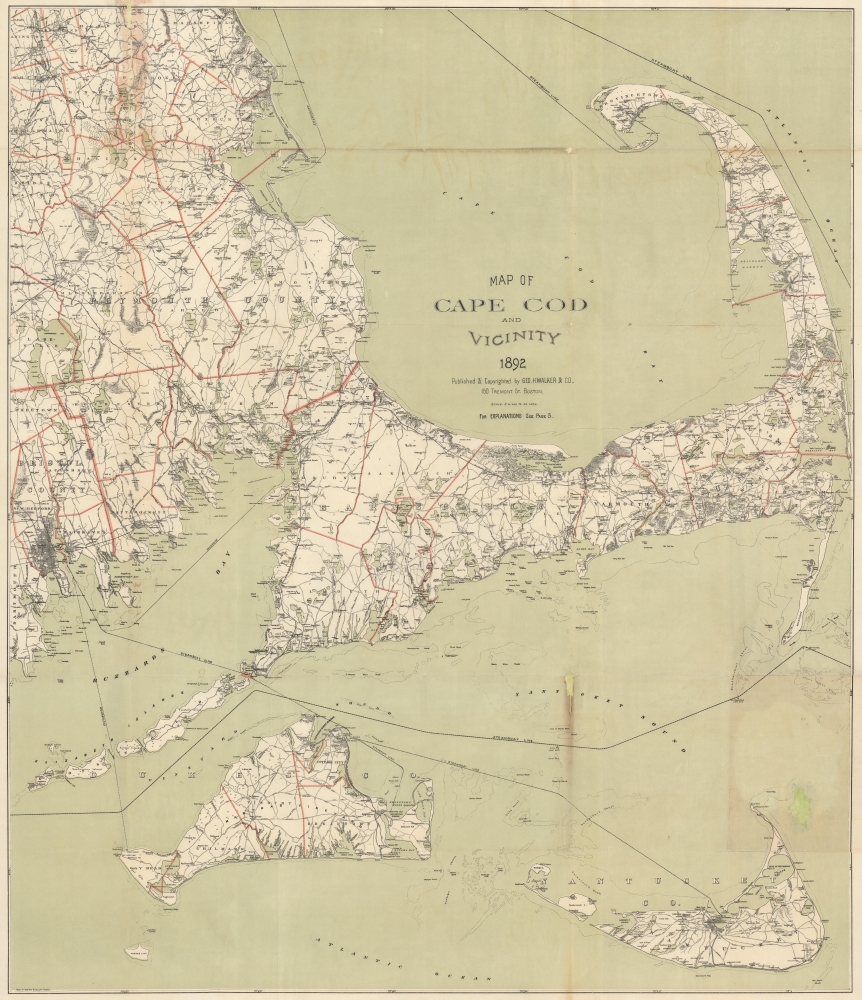1892 Walker Folding Map of Cape Cod, Martha's Vineyard, Nantucket and Vicinity
CapeCod-walker-1892
Title
1892 (dated) 28.25 x 32.75 in (71.755 x 83.185 cm) 1 : 126720
Description
A Closer Look
The map depicts from New Bedford east to the Atlantic Ocean and from Duxbury and Provincetown south to Nantucket. Red lines mark the borders of towns, and roads are traced and labeled throughout. Railroad lines and ferry and steamship lines are also noted, providing comprehensive transportation information to travelers and locals alike. Waterways, swamps, shoals, lighthouses, and other maritime and coastal features are also recorded.The Turn of the Century Bicycle Boom
Though invented in the early 19th century, bicycles only became commercially accessible and popular in the closing decades of the 19th century. At first, 'penny-farthing' or high-wheeled bicycles became popular in the 1870s and 1880s, but they tended to be dangerous and uncomfortable to ride. A range of innovations in the following years made the machines more reliable, safe, comfortable, and affordable, and they became fashionable for their applications in transportation, leisure, and sport on both sides of the Atlantic. As would later happen with automobiles, cycling clubs sprang up to scour for the best routes, advocate for improved roads, and connect enthusiasts (for instance, the Massachusetts Bicycle Club was founded in 1879 in Boston). With regard to the present map, the quaint small towns and seaside roads of Cape Cod, Nantucket, and Martha's Vineyard were especially well-suited for bicycles.Cycling was particularly popular among women, as it provided freedom of movement and association outside of the home. At first, penny-farthings were preferred by men, while modern bicycles, dubbed 'safety bicycles,' were marketed towards women. The bicycle craze peaked in the 1890s and was an early example of American consumer culture, with products explicitly marketed towards women. The popularity of cycling among women set off a range of cultural changes; for instance, the elaborate Victorian dress was scaled down to allow women the freedom of movement to ride bicycles, resulting in shorter skirts and bloomers, which were effectively pants. Some historians even credit the bicycle as prompting a wider push for women's rights and suffrage.
Publication History and Census
This map was created and published by George H. Walker and Company in 1892; a 1902 edition (also sold by us) was later issued, as was a 1907 edition. Regardless of edition, the map is rare, with the present edition being listed in the OCLC among the holdings of Yale University, the American Antiquarian Society, Harvard University, the Boston Athenaeum, the State Library of Massachusetts, Williams College, Princeton University, and the National Library of Australia.Cartographer
George Hiram Walker (January 4, 1852 - November 14, 1927) was a Boston based publisher of books, views, and maps active in the late 19th and early 20th centuries. Born in Springfield, Vermont, Walker started his life as a dry goods merchant but developed an active interest in publishing during the early 1870s. Walker began publishing in 1878 when he partnered with an unknown New York Firm. Two years later, Walker brought the operation in house by partnering with his brother, Oscar W. Walker, in the opening of a lithography studio at 81 Milk Street, Boston. Shortly thereafter the firm expanded to new offices at 160 Tremont Street, Boston. The Walker brothers produced a large corpus of works, most of which focused on travel and tourism in New England. Walker also established the Walker-Gordon Milk Laboratory with Dr. Thomas Morgan Rotch and Gustave Gordon. This interesting investment was based on the premise that infant deaths could be avoided by providing higher quality milk. The company eventually became a great success, producing a high-quality cow milk that closely resembled human breast milk. In the process the Walker-Gordon laboratory developed many of the dairy health standards that are still with us today. Walker married Irene L. Loud on March 25, 1885. More by this mapmaker...




